The Wildflower Trail at the Acton Arboretum
by Bruce Carley
* Site Map *
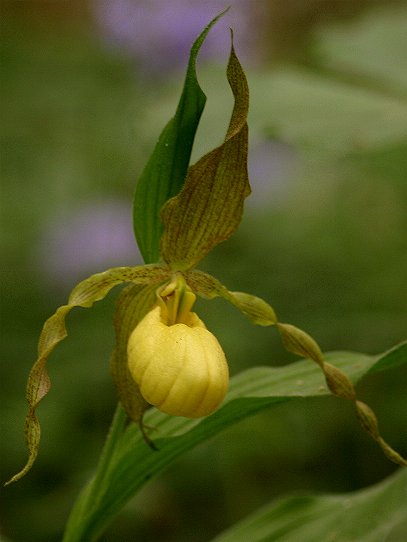
Large yellow lady slipper (Cypripedium pubescens)
by Bruce Carley
* Site Map *

Large yellow lady slipper (Cypripedium pubescens)
The trails which run through the Acton Arboretum (Acton, Massachusetts) are home to many native wildflowers, some planted, some naturally occurring. As a long-time gardener of native New England wildflowers, I have been in charge of enhancing and maintaining the naturalistic gardens along this Arboretum's Wildflower Trail since 1995, and I have posted this picture-article to call attention to some of the woodland species that can be seen growing along this forest floor habitat, and also to suggest some of these species as workable additions to gardens. All of the species depicted or mentioned on this page are native to the forests of eastern, temperate North America, and with few exceptions their natural ranges extend into the New England states. These particular species were selected for use in this project because of their combination of attractiveness, relative ease of propagation, and in some cases a considerable need for conservation by means of cultivation. The wildflower populations at the Arboretum at this point are quite extensive and well worth an effort to visit them, especially during the spring months.
Many native species spread prolifically and deserve our attention as possible additions to gardens, while others are best admired in their natural habitats and left alone. Species whose populations are fragile or slow to reproduce are especially in need of protection from human interference. Orchids, trilliums, and gentians tend to be particularly vulnerable, as even the picking of their flowers can interfere with their natural reproduction and can decimate populations. Indeed, the collection of native plants from their natural habitats is often against the law, in addition to being unethical and damaging to the environment. Most of the native plants featured in the naturalistic gardens at the Acton Arboretum were purchased originally from suppliers who propagate their own stock, most prominently the New England Wild Flower Society.
Wildflower Videos: In 2007, I created a video showing a selection of native Spring Wildflowers of eastern North American woodlands. This video will appear above in most browsers (the 64-bit version of Internet Explorer may be necessary on some systems) and should start when the Play button is clicked; or you can click the preceding link for a separate page with more details about the video's contents. Or you can download this 28.5 megabyte video directly. The background music is my composition, Nirvana from 2002. I also have created videos of Cypripedium parviflorum, and Summer Wildflowers, each viewable on separate pages.
Some species of ladyslipper (Cypripedium) can be cultivated easily enough, but these plants are fragile and slow-growing, and they should not be collected from wild populations unless there is an immediate need to rescue them from so-called development. In the case of the familiar pink lady slipper (C. acaule), digging the plant almost always kills it within a few years, because it is utterly dependent on the presence of healthy colonies of soil fungi for its absorption of nutrients. If it is unavoidably necessary to attempt rescuing pink lady slippers, it is prudent to unearth as wide a rootball as possible with each plant, and to replant in locations where other pink lady slipper plants already are growing naturally, so that the transplanted individuals may have a chance of surviving for more than a year or two.
Other ladyslipper species are not dependent on soil fungi beyond their seedling stages and are therefore much easier to maintain in gardens. My efforts to cultivate the large yellow lady slipper (C. pubescens) have been successful on a small scale. Professional seed propagation of ladyslipper species is a complicated practice that is barely out of its infancy; however, at least a few laboratories are successfully propagating and selling seedlings of a number of Cypripedium species, including most of those which occur naturally in New England. The large yellow (C. pubescens), the small yellow (C. parviflorum), the showy or queen's (C. reginae), the small white or prairie (C. candidum), and the ram's-head (C. arietinum) lady slippers are rare and imperiled throughout their natural ranges in eastern North America, so any successful, large-scale propagation of these species for cultivation in gardens may be their ultimate salvation. Interested individuals can look to such sources as Spangle Creek Labs, Hillside Nursery, Raising Rarities, Thimble Farms, Wild Orchid Company, and Vermont Ladyslipper Company for seedlings of these species. The Gardens at Post Hill website provides links to a number of additional suppliers of these and other terrestrial orchids native to temperate North America.
The various native wildflowers planted along the Acton Arboretum's Wildflower Trail reach their flowering height in April or May, with only a few exceptions which flower during the summer. The earliest plantings, many of them labeled, are on the left as you walk along the boardwalk away from the two farm ponds. This hillside area represents the original wildflower collection that was created in 1993 by a local volunteer (who moved a few years later, whereupon the responsibility for maintaining and enhancing this garden was passed to me). Since that time, additional wildflower populations have been introduced extensively further along the trail, in some cases simply by broadcasting seeds collected from mature plants, and these new populations are becoming increasingly conspicuous each year - some of them on a large scale. Anyone in need of a map of the Arboretum can view my home-prepared version, a modified adaptation of a publicly available sketch.
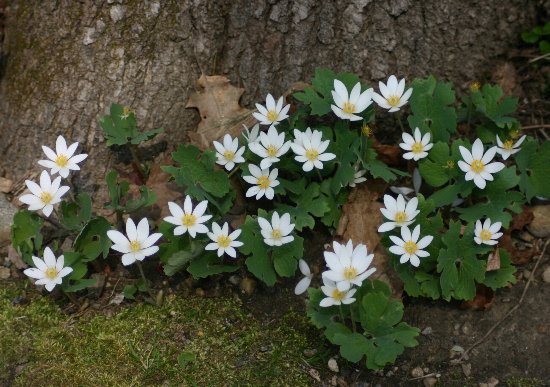
A patch of bloodroot (Sanguinaria canadensis)
As the spring season gets under way, the first wildflower one may notice is likely to be bloodroot, a native member of the poppy family which flowers briefly in the early spring - usually in April, although the exact days of its flowering in any given year always depend on the timing of warm weather. Indeed, many of the species featured in these gardens are spring ephemerals, so called because they flower briefly in the spring to take advantage of the brief period of full sun which occurs in woodlands before the overhanging trees leaf out for the season. Few flowers are more ephemeral than those of bloodroot, which provide an attractive show for a few days at most, before they fade for the season. However, bloodroot makes up for the brevity of its flowering by its showiness and extraordinarily prolific habit. This species is easy to propagate both by seed and by division of its root stock, and it has become a prominent presence along the Wildflower Trail. Most of the bloodroot plants now occurring along this trail were established merely by scattering seeds along the forest floor in suitable areas. Certain naturally occurring annual and biennial species such as jewelweed, cleavers, and the non-native celandine appear to be reliable indicators of suitable soil for this purpose.
|
|
Although bloodroot occurs naturally in most regions of eastern North America, it is not nearly as common as it had been in the original, primieval forests of the area. When those forests were cleared in the 1600's, many native plant populations suffered severe setbacks. Some species recovered efficiently enough after the clearings were allowed to revert back to forest, but others had greater difficulty. The challenge for bloodroot seems to have been related to its dependence on ants for the distribution of its seeds. Each seed presents an edible attachment which an ant drags underground and consumes, leaving the seed in an ideal position to germinate; however, unlike birds, ants are limited in their ability to transport seeds across considerable distances or areas paved by humans. Because of widespread human disturbance of natural areas, this once-common plant has tended in recent years to become locally isolated and more or less limited to areas which had not been cleared.
|
|
Toward the end of April, assuming that the unpredictable warmth of the early spring has been occurring at more or less the usual times, we can expect to see the ephemeral flowers of the earliest species. Besides bloodroot, these species include Dutchman's-breeches (Dicentra cucullaria) and its close relative, squirrel-corn (D. canadensis), both members of the bleeding-heart family. Dutchman's-breeches is so named because its flowers resemble sets of trousers hanging on a line. Squirrel-corn is similar, except that its flowers are shaped more like those of a typical bleeding-heart plant. Both Dutchman's-breeches and squirrel-corn can be seen in flower along the Wildflower Trail in late April and early May, when the difference between their flowers may be noticed by a sharp eye. Shortly afterward, both species go dormant for the year, and even their leaves cease to be visible above the ground, true to the ephemeral nature of these plants. Both species are fairly easy to cultivate and to propagate, once established, and unusually among wildflowers, both can be propagated by separating the many tiny corms which comprise their root systems and scattering them like seeds on suitable sites. In this way, many more plants of flowering size can be generated within a few years. Because of their relative ease of propagation, these two species, like bloodroot, are among the more prominent features along the Wildflower Trail.
|
|
Trilliums are among the more famed and showy of native wildflowers. The white and red species depicted above each tend to flower in April and early May. Both are featured in fair quantity along the Wildflower Trail, where they thrive and flower in fair quantity each year. Many of the Arboretum's white trilliums were acquired through a fundraiser in 2007, and the somewhat more numerous red trilliums came from several donors. Although trilliums can be propagated successfully either by seed or by division, these plants tend to be quite slow to propagate, making them relatively expensive and difficult to find in the nurseries. Some nurseries propagate their own trilliums for sale; however, because of the inevitable temptation of expediting sales by collecting trilliums from native populations, prospective buyers should make sure that they purchase trilliums only from suppliers who propagate their own stock. Trillium plants also are uncommonly sensitive to being damaged or set back in their growth by careless treading or picking, which is why they should not be dug from native populations except where there is a need to rescue them, and of course they should never be picked.
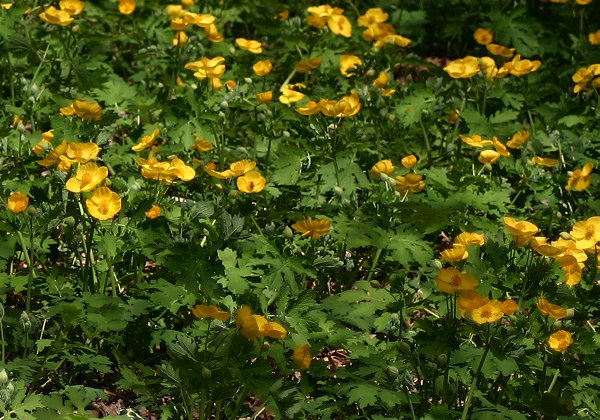
Wood poppy (Stylophorum diphyllum)
The bright yellow wood poppy, a native of the midwestern states, also begins to flower around the end of April or the beginning of May, when it becomes conspicuous in large numbers along the Wildflower Trail. Like bloodroot and other members of the poppy family, the wood poppy is showy when in flower, self-fertile and extrordinarily prolific, and full of a brightly colored, toxic sap that protects it from predation. Also typical of this family, like bloodroot, it has that same natural adaptation for seed distribution by ants. As with bloodroot, the wood poppy can be grown in phenomenal quatity by broadcasting its seeds over a moist, exposed forest floor, as one might do with grass seed to create a lawn. The wood poppy patches at the Arboretum were established in exactly this manner; in fact, I have ceased efforts to increase this prolific species here, as it seems prudent to keep its presence moderate. But when carefully moderated, it forms an attractive and welcome addition to the Arboretum's collection of native wildflowers.
|
|
Virginia bluebells, another showy native wildflower, is one of the most desirable companions for the wood poppy, as it produces brightly colored flowers at the same time of year and goes completely dormant not long afterward, precluding any risk of being crowded out by its aggressive companion. In contrast to the fleeting blooms of the earlier ephemerals, the flowers of these two species last for a few weeks during April and May. Although Virginia bluebells can be propagated by seed, I have had much better success in propagating it by dividing the root stock in the early spring, before the shoots of the plant become prominent above the ground. At the Arboretum, several plants of this species are on display in the original wildflower collection area near the boardwalk, and many additional examples have been planted further along the trail.
|
|
In the middle of May, after the wood poppies and Virginia bluebells have begun to fade, wild columbine and foamflower begin to reach their flowering height, marking what is perhaps the showiest period for the majority of woodland wildflower species in the region. Wild columbine produces one of New England's most unusually shaped and intriguing flowers, which are bright red and tube-shaped for the purpose of attracting a specific pollinator, the ruby-throated hummingbird, with which it may have evolved symbiotically. Fortunately for this plant, insects also pollinate its flowers, thus compensating for an absence of hummingbirds at any given time. The wild columbine has a relatively short life span and depends heavily on its ability to reproduce in quantity by seed, but it will spread prolifically when planted in suitable sites. This species is most likely to occur naturally on open ledges or slopes that are rich in limestone, so a generous amount of lime added to the soil will encourage this species to thrive, assuming that it also has enough direct sunlight. The soil and light conditions along most of the Arboretum's Wildflower Trail are less than ideal for this species, but it has been established here on a moderate scale and is sure to grow vigorously in nearby open areas which provide better light conditions.
Foamflower is a prolific ground-covering species which spreads by creeping runners to cover large areas. Its spikes of tiny white flowers resemble sea foam and add a delicate touch when grown in combination with other species. The roots of this species tend to be rather shallow, making the plants potentially susceptible to drought, and cultivated patches of it may require considerable watering during dry periods in the summer. This species can be propagated easily by seeds sown in a flat, but unlike bloodroot and wood poppy, it is not easy to establish on site by broadcasting seeds along the ground. At the Arboretum, I have been able to establish patches of foamflower by dividing small plants apart from larger colonies and transplanting them, so the species probably will become a more conspicuous presence along the Wildflower Trail as time goes by. I also have been able to establish patches of the native wild ginger (Asarum canadense) and May-apple (Podophyllum peltatum) along the trail in this same way, as they too are more easily propagated by division than by seed and respond well to manual planting.
|
|
Also during May, we can observe several types of violets growing along the Wildflower Trail. Violets are familiar emblems of spring, and they need not be considered weeds, even though some violet species can be aggressive. In addition to the familiar blue species, violets come in yellow-flowering, branching forms, such as the species depicted above. These yellow violets are nearly as prolific from seed as their blue relatives, but unlike the blue violets, they add an interesting dimension to native wildflower gardens without crowding out other plants. The yellow violets at the Arboretum can be expected to spread prolifically in the foreseeable future, thus enhancing the trailsides considerably.
Many garden varieties of phlox have been derived from species which occur natively in eastern North America, such as the wild blue phlox which is featured prominently in the Wildflower Trail. This species occurs naturally in an assortment of flower colors, and it reaches its flowering height in the middle of May, coinciding with the flowers of wild columbine, foamflower, and yellow violet, and thus contributing to a colorful, seasonal show. This woodland phlox is well adapted to the soil conditions of the New England forest floor, and it propagates far more readily by stem cuttings or divisions than by seeds. As with foamflower, I have been able to establish patches of this species at the Arboretum by dividing larger patches of it and transplanting the divided sections to suitable sites, where they are likely to expand considerably, allowing the species to become a prominent presence along the Wildflower Trail.
|
|
The white baneberry or doll's-eyes, and the closely related red baneberry (A. rubra), also can be observed flowering or fruiting along the Wildflower Trail. Both species produce attractive clusters of white flowers in May. The red baneberry produces its bright red berries in the late spring, and it also comes in a form which bears white berries at the same time. Its relative, the white baneberry (not to be confused with the white-fruited red baneberry), fruits much later, in August. Both of these species are moderately present at the Arboretum, and it is my hope that they can be made to increase somewhat over the years, both by seed and by division.
Wild geranium occurs naturally in open meadows and clearings at the Arboretum and elsewhere around town, yet it also is adaptable to woodlands and is found occasionally in shady conditions. A few natural patches of it can be observed flowering in late spring in several spots along the Wildflower Trail. Aggressive as it can be in meadows and open woodlands, this prolific, native species will enhance a shady trail without crowding out other species here. Although the invasive garlic mustard and European celandine are best removed from the trailsides, it is my preference to leave the native geraniums intact, allowing them to contribute to the collection.
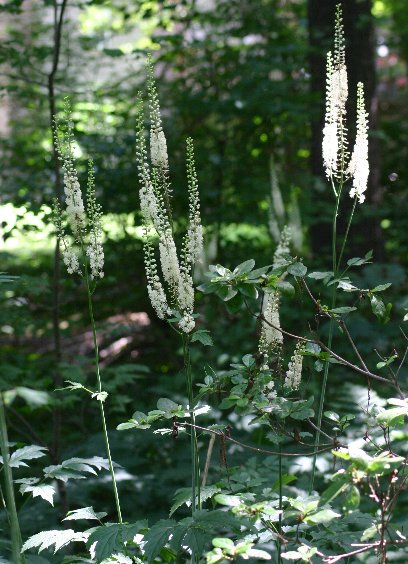
Black cohosh (Actaea racemosa)
Returning to the Wildflower Trail in July, long after the vast majority of woodland flowers have faded for the season, we may observe tall stands of black cohosh in flower. This species is relatively unique among woodland wildflowers in that it produces showy flowers and effectively lights up the woods at a time when the flowers of nearly all other woodland species are gone for the season. The flower stalks commonly reach 4-6 feet above the ground. The flowers produce the pungent fragrance of carrion, quite unlike the sweet scent of other flowers, and bees and other insects revel in it and pollinate the flowers in the process. Natural populations of this species are rare throughout the northeast and in danger of extirpation in Massachusetts, yet this plant is widely available in the trade and easy to grow. Indeed, it is commonly grown commercially for use as an herbal remedy for hormone regulation. This species propagates easily both by seed and by division and is consequently becoming more prevalent in the woodlands of the Acton Arboretum.
Ferns add a distinctly naturalistic character to gardens when planted alongside flowering plants, and a number of native fern species may be of particular interest for this purpose. Many ferns have been planted along the Wildflower Trail at the Arboretum, emphasizing marginal, male, and Goldie's woodferns (Dryopteris marginalis, D. filix-mas, and D. goldiana, respectively), Christmas fern (Polystichum acrostichoides), Braun's holly fern (P. braunii), maidenhair fern (Adiantum pedatum), and ostrich fern (Matteuccia struthiopteris). Many of the more common fern species are suitable for cultivation as well, and some of them occur naturally along the trail. Some ferns can be propagated easily by division, while others cannot, but most can be propagated in quantity by dusting their spores on the surface of a flat of soil and leaving the flat in a bright location for a few months, checking it regularly to maintain moisture and to control mosses and fungi. I have had remarkable success with this practice on a number of fern species, including the Braun's holly fern, an attractive native species that never has been common within its natural range. In Massachusetts, native populations of this fern are found only on the slopes of Mount Greylock, where they are considered endangered. In 1990, I collected a fertile leaf of this species from a plant growing in a garden maintained by the New England Wild Flower Society, and I was able to propagate it easily from its spores and to establish a number of plants of it along the Arboretum's Wildflower Trail, where they often remain dark green and shapely well into the fall. Anyone with an interest in native ferns perhaps will want to explore this section of the trail for the relatively unusual species which have been planted here.
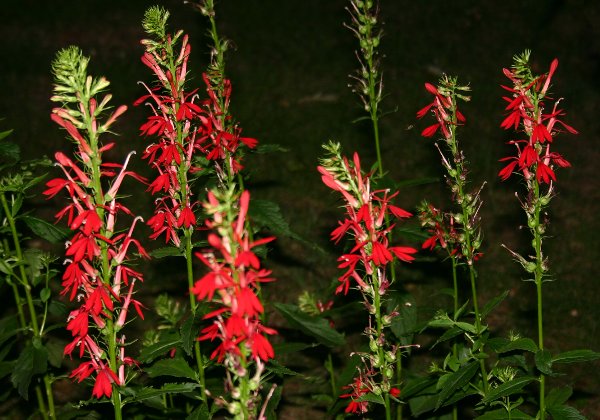
Cardinal flower (Lobelia cardinalis)
A few more summer-flowering species deserve mention as well, even though they prefer wet soils along relatively open shores and streams. Although they may not grow so well in the shade of woodlands, these species have proven fairly adaptable to cultivation in other situations, provided that the soil is kept moist at all times and is never allowed to dry out. The bright red cardinal flower grows naturally along semi-shaded streamsides and pond shores, and it flowers in August. It is becoming less common in many parts of its range, perhaps largely because of overpicking, on top of its dependence to some degree on pollination by hummingbirds; however, the ease with which this strikingly attractive, native lobelia can be propagated and maintained in gardens would seem to warrant its greater use in cultivation. Once established in a truly suitable site, this species may self-seed prolifically. A shortage of suitable habitat along the Wildflower Trail at the Acton Arboretum may preclude the establishment of this species here, but a fairly large patch of it has been established along the swale near the Arboretum's main entrance. The bold flowers of this species also may catch one's eye along streams at Nashoba Brook and other conservation lands in Acton. Its close relative, the great blue lobelia (L. siphilitica), is also easy to cultivate in the same type of habitat, and it propagates easily in the same way.
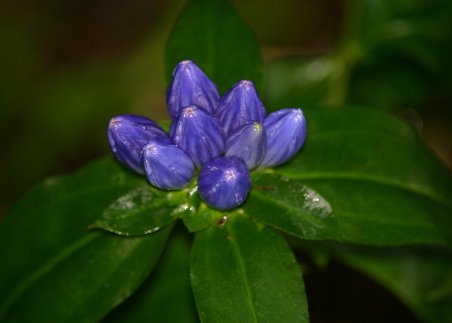
Closed gentian (Gentiana andrewsii)
The closed gentians, including the species depicted above and its close relative, G. clausa, occur naturally along shady streams and in moist thickets, and they flower in September. These plants, too, are becoming less common in their natural habitats, possibly in part because of overpicking. Gentians produce extremely small seeds on which they depend heavily for their proliferation, which is why they should not be picked. The deeply indigo flowers of the closed gentians do not open on their own, yet worker bees have no trouble forcing their way inside to collect nectar and to transport pollen. Gentians tend to be challenging to grow, and the closed gentians represent possibly the least difficult members of this family. They require moist to damp, relatively neutral soil in sun or partial shade, and they can be propagated by cuttings, division, or seed. Unusually among gentians, G. clausa seems to be fairly easy to propagate by direct seeding in suitable sites during the fall. At the Acton Arboretum, some healthy plants of G. clausa were established near the cardinal flower in the swale mentioned above, simply by scattering seeds on site in the fall and waiting a few years. Many healthy clumps of the species also were established successfully in the meadows and shores of North Acton Recreation Area (NARA Park). The seeds of other gentians, including G. andrewsii and the biennial but singularly attractive fringed gentian (Gentianopsis crinita) may need more careful treatment if they are to grow successfully. The tiny seeds, scattered on the surface of a flat in the fall and left outdoors during the winter will sprout uniformly the following spring, and they will require an entire growing season in constantly moist soil to become firmly established as seedlings. Then they can be separated into clusters of small plants and transplanted carefully to suitable locations.
Of all my activities with native plants, the most important to me is the special project through which I am propagating and raising disease-resistant, purely American elm trees for distribution to local conservation areas and sale to organizations and residences. Please visit my article, Saving the American Elm, which features more quality photographs as well as links to sources of trees and information, including an Elm Sapling Gallery showing many of the elm saplings which I have planted in Acton.
Please also visit my article, New Hope for the American Chestnut, which presents valuable information on a highly promising effort to restore this ecological keystone to the forest canopy through breeding for blight resistance.
The photographs on this page were taken at various times by my father, Gilbert Carley. They may be distributed freely or republished for wholesome purposes; in return, a credit link ("courtesy elmpost.org") is always appreciated.